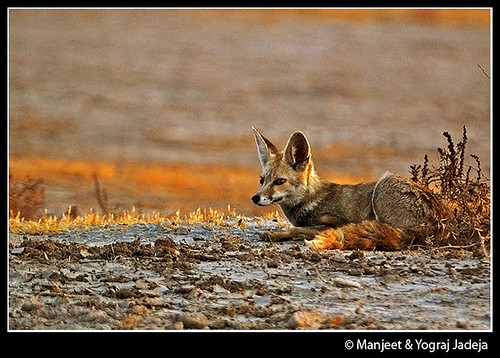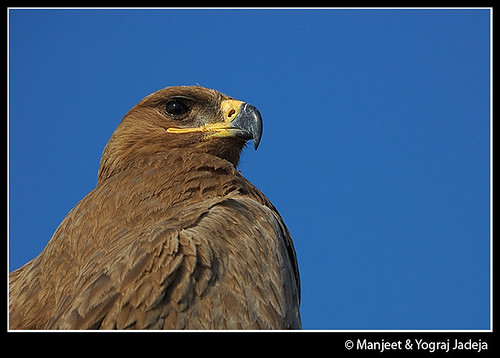The best time to visit the wild ass sanctuary is from november to February as the biodiversity is at its peak during this time, the terrain is motor-able and the heat is bearable.
We thought it would be interesting to notice the changes in density and variety of wildlife in march and to experience the desert during the summer months.
We left Ahmedabad at 4a.m. (getting up that early is the toughest part) taking the route through sanand-viramgam-malvan and took a sharp right (almost U) turn from malvan to bajana, where we picked up our guide and got the permit to enter the wild ass sanctuary.
We felt at ease on reaching there as the horrifying traffic of the highway had vanished, giving way to trails, bushes and open desert. It was almost 6:45 a.m. when we reached there, thanks to a closed railway crossing that had to be opened after the train that was expected to cross, trickeled to a halt, just a few yards from the crossing. we drove a few miles to reach an oasis that was a haven for wildlife, we spotted pelicans (not spotted but rosy pelicans), flamingos, spoonbills, grey herons, a few ducks and waders.By now the water had reduced to a fraction of its size when we visited in winter, and the density and variety of birds had decreased dramatically.

The Greater and Lesser Flamingos feeding together
the difference in size and colour of the beak is obvious.
The sandy bumpy trail on which we were rocking gradually turned into a firm bone rattling one. As we took a turn we realized that we were in the middle of a mine field of sand grouses that took off around us as we drove through.

Chestnut Bellied sand grouse rely on their camouflage to elude hunters.
Just off the trail we spotted a group of Nilgai being harassed by a small group of stray dogs. Judging from the health of the dogs we could conclude why its wild cousins - the foxes, wolves, hyenas and jackals call this place home,but they were nowhere to be seen as we rattled along, checking out areas of frequent sightings, at times creating a dust storm of our own behind the vehicle.
The Peregrine Falcon is another beautiful raptor that can be found here, and it made a guest appearance, flying past us just as we were talking about it. It had fattened up considerably, which reminded us to have our fill.

The fastest bird in flight can reach speeds upto 320 km/h
while stooping on its prey from above.
we had our lunch at the watch-tower and drove a few miles to stumble upon a small group of blackbucks, on stopping the vehicle we realized that we had paid the price for not driving carefully, no the traffic police was not following us but one of our tyres was punctured and changing it under the desert sun was an unforgettable experience.

Its a struggle for survival for the people and wildlife of the desert.
The endangered wildlife could face devastating consequences in case of a drought.
We headed straight for Patdi a few miles that seemed like light years in the desert terrain. We took a more civilized tar road back to Bajana, where we rested out the afternoon under a tree, in company of a few locals who chatted away endlessly, while a variety of common birds visited the 'Parab' (a small water tank) nearby.
As the mercury dropped to a more tolerable level in the evening we ventured deep into the desert, hoping to get a glimpse of the extremely shy Desert fox. Trucks could be seen carrying salt from the salt mines while people worked endlessly on salt production. Watching all this we could not help but think how one greedy species could claim every bit of land on the planet as its property.
As the sun started to sink towards the horizon we came across a lonely stallion grazing, unfazed by the storm of dust that passed over it. As the dust disappeared we could see that something had appeared behind the Gudkhar (wild ass in local language) a close look through the viewfinder revealed that it was the desert fox. Driving between the two we could get close to the fox that was quite wary. It was a breathtaking sight to witness this beautiful creature from close quarters as the last rays of sun kissed its fur giving it a surreal appearance.


The Desert Fox is only found in the Thar desert in Rajasthan and Kutch, Gujarat.
It has keen sense of smell and hearing, which it relies on to find its prey.
We returned back with unforgettable memories. A crane (not the bird) and heaps of salt reminded us once again of how we exploit nature but forget that we depend on it as well.

If we continue to inflict damage to these last pockets (not just this sanctuary) of natural splendor, the holes that we create in these pockets could unknowingly allow the little natural wealth that is left to trickle down until one day when we realize that there is none of it left for us.

The Endangered Indian Wild Ass could suffer heavily in case of a drought
Than the Earth would seem like a 'DESERT'
(the one that we started the article with)



